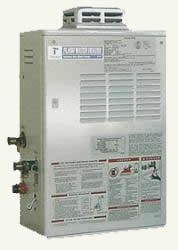
Figure 1 - Tankless Hot Water Heater
Consider changing your hot water tank to a tankless system if you are undertaking any home improvement that involves the bathroom, kitchen or change to your plumbing system. If you have a plumber working on a home improvement, it will generally be less expensive to add work than to call in a plumber for a specific tankless water heater installation.
Changing your hot water tank to a tankless system takes on even more economic value if you have to replace your current hot water tank because of age or if can no longer satisfy the hot water demand of your growing family.
With the price of a kilowatt hour of electricity and gas rising each and every year, becoming energy efficient has gone from being only a social consideration to a very serious budget consideration.
One way that a home owner can save money on their electric bill is to convert from a conventional tank style hot water system to an on demand or as they are sometimes called a tankless, hot water system.
An on demand hot water system works, just as its name implies, by heating water only when there is a demand, within the home for hot water. Incoming cold water is connected to the tankless system, which is a high efficiency heat exchanger. Electric or gas heating elements wrapped around the piping within the tankless system transfer heat to the water at a very high efficiency. The only time the gas or electric elements are turned on is when someone opens a hot water tap within the home. The system senses the reduction in pressure, water flows through the coils within the on demand system and heat is transferred from the elements to the coils and then to the water. The instant that the demand has stopped, the faucet, or tap is turned off, the elements are turned off.
Retrofitting a tankless system is not a difficult project, as the on-demand systems are about the same size as a briefcase they will readily fit in any location where there is currently a hot water tank.
An electrically powered on demand hot water system require a large amount of electricity for short periods of time, a unit for an average home will require between 50 and 60 amps at 230VAC nominal. This means that the incoming electrical service to the home should be a minimum of 200 amps. The wiring that currently runs from the electrical panel to the hot water tank will most likely have to be upgraded, as most hot water tanks operate on a 30 amp to 40 amp circuit.
A complete selection of tankless water heaters.
